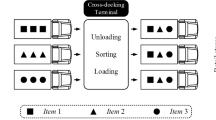Abstract
Consider an inventory system with one supplier, two retailers, Poisson demand, and constant lead times. One retailer has a higher demand rate and can ship items to the other retailer when facing a stock out, for example. Arriving demands to any retailer are lost if it is out of stock, and it is not possible to initiate a transshipment. Retailers apply one-for-one-period ordering, (1, T), policy. We derive the long-run average cost, prove its convexity, and show that it is independent of the lead time. We present an algorithm to find the optimal solution and minimize the system cost. We show that for long lead times, applying one-for-one-period ordering policy results in a lower cost than the base stock, (S-1, S), policy, so it is preferred in long lead time condition.
Similar content being viewed by others
References
Alfredsson P, Verrijdt J (1999) Modeling emergency supply flexibility in a two echelon inventory system. Manag Sci 45(10):1416–1431
Axsäter S (1990) Modelling emergency lateral transshipments in inventory systems. Manag Sci 36(11):1329–1338
Axsäter S (2003) Evaluation of unidirectional lateral transshipments and substitutions in inventory systems. Eur J Oper Res 149(2):438–447
Grahovac J, Chakravarty A (2001) Sharing and lateral transshipment of inventory in a supply chain with expensive, low demand items. Manag Sci 47(4):579–594
Graves SC (1985) A multi-echelon inventory model for a repairable item with one-for-one replenishment. Manag Sci 31(10):1247–1256
Haji R, Haji A (2007) Introducing one-for-one period ordering policy and its optimal solution based on queuing theory. J Ind Syst Eng 1(3):200–217
Haji R, Pirayesh Neghab M, Baboli A (2009) Introducing a new ordering policy in a two-echelon inventory system with Poisson demand. Int J Prod Econ 117(1):212–218
Lee HL (1987) A multi-echelon inventory model for repairable items with emergency lateral transshipments. Manag Sci 33(10):1302–1316
Olsson F (2010) An inventory model with unidirectional lateral transshipments. Eur J Oper Res 200(3):725–732
Paterson C, Kiesmüller G, Teunter R, Glazebrook K (2011) Inventory models with lateral transshipments: a review. Eur J Oper Res 210(2):125–136
Sherbrooke CC (1968) METRIC: a multi-echelon technique for recoverable item control. Oper Res 16(1):122–141
Smith SA (1977) Optimal inventories for an (S-1, S) system with no backorders. Manag Sci 23(5):522–528
Author information
Authors and Affiliations
Corresponding author
Appendices
Appendix 1: convexity of the total cost function
Let \( f(x)=1-x\left(1-{e}^{-\frac{1}{x}}\right),x>0 \), then:
Lemma 1 f(x), x > 0, is convex and decreasing.
Proof First and second derivatives of f(x) are \( \frac{ df(x)}{ dx}=-1+{e}^{-\frac{1}{x}}\left(1+1/x\right) \), and \( \frac{d^2f(x)}{d{x}^2}={x}^{-3}{e}^{-\frac{1}{x}} \). The second derivative is clearly positive for x > 0, so the convexity of f(x) follows. Also, the positive second derivative means that the first derivative is increasing in x, and because df(x)/dx → 0− as x → ∞ then df(x)/dx < 0 for x > 0, i.e. f(x) is decreasing. □
Now, rewrite TC from (14) as follows:
To show the convexity of TC, we observe that f(·) is convex from Lemma 1, then as π 1 > τ, it is sufficient to show that f(I 1)f(I 2) is convex for positive I 1 and I 2.
Theorem 2 f(x) · f(y) is convex for x > 0 and y > 0.
Proof By definition, we are to show that for all (x 1, y 1) and (x 2, y 2), the following inequality holds
Starting from the left-hand side of (17), LHS, due to convexity of f(·), we have
Now, without loss of generality, one can assume x 1 ≥ x 2, and consider two cases for y where y 1 ≥ y 2 and y 1 < y 2. (Note that x 1 and x 2 are arbitrarily indexed, and x and y are interchangeable in f(x) · f(y).)
When y 1 ≥ y 2 , because f(·) is decreasing (from Lemma 1), then f(x 1) ≤ f(x 2), and by multiplying both sides by [f(y 1) − f(y 2)] ≤ 0, we obtain
Then from (18), we have
And this concludes (17) and the convexity of f(x)f(y) for this case.
When y 1 < y 2 , by multiplying both sides of f(x 1) ≤ f(x 2) by [f(y 1) − f(y 2)] > 0, we obtain
Then from (18) we have
where the last inequality is because f(∙) is decreasing. This concludes (17) and the convexity of f(x)f(y) in this case. Thus, (17) holds for any (x 1, y 1) > 0 and (x 2, y 2) > 0, and the convexity of f(x) · f(y) is concluded. □
This theorem 2, along with the convexity of f(·), directly yields the convexity of TC.
Appendix 2: convergence of the procedure
Proof We show that the procedure introduced in Section 2 (to obtain the optimal average inventory levels I 1 and I 2) is convergent following a discussion on some properties of Eqs. (15) and (16).
Equation (15), that is, \( {e}^{-\frac{1}{I_1}}+\frac{1}{I_1}{e}^{-\frac{1}{I_1}}=1-{h}_1{\left[{\mu}_1\left({\pi}_1-\tau \right)\left[1-{I}_2\left(1-{e}^{-\frac{1}{I_2}}\right)\right]+\tau {\mu}_1\right]}^{-1} \), has the following properties (see Fig. 2 for illustration):
-
Property 1 I 2 is strictly decreasing in I 1 for I 1, I 2 > 0. This is because \( 1-{I}_2\left(1-{e}^{-1/{I}_2}\right) \) is strictly increasing in I 2 > 0 and since π 1 > τ. Then, the right hand side (RHS) of (15) is strictly decreasing in I 2 > 0. Also, the left-hand side (LHS) of the equation is strictly increasing in I 1 > 0. This yields the property. □
-
Property 2 I 1 can be obtained about which I 2→ 0. Using Eq. (15) we can obtain the limit of I 1 (i.e., I 01 in step 1) when I 2→ 0 by solving
$$ {e}^{-\frac{1}{I_1}}+\frac{1}{I_1}{e}^{-\frac{1}{I_1}}=1-\frac{h_1}{\pi_1{\mu}_1}. $$(19) -
I 1 < ∞ because h 1 ≠ 0. Note that (19) is the same as (5), and obtaining I 1 from Eq. (19) is step 1 of the proposed iterative procedure in Section 22. □
Property 3 I ∞1 can be obtained about which I 2→∞. We have \( {I}_2\left(1-{e}^{-\frac{1}{I_2}}\right)\to 1 \) when I 2→∞. Thus, we can obtain the value of I 1 about which I 2→∞ by solving
$$ {e}^{-\frac{1}{I_1}}+\frac{1}{I_1}{e}^{-\frac{1}{I_1}}=1-\frac{h_1}{\tau {\mu}_1}.\square $$(20) -
Property 4 I 1 in (19) is greater than I 1 in (20). This is because τ < π 1; therefore, the RHS of (19) is greater than the RHS of (20), and also the LHS is strictly increasing in I 1. □
Equation (16), that is, \( {e}^{-\frac{1}{I_2}}+\frac{1}{I_2}{e}^{-\frac{1}{I_2}}=1-{h}_2\left[{\mu}_1\left({\pi}_1-\tau \right)\left[1-{I}_1\left(1-{e}^{-\frac{1}{I_1}}\right)\right]+{\pi}_2{\mu}_2\right] \), has the following properties (see Fig. 2 for illustration):
-
Property 5 I 2 is strictly decreasing in I 1, for I 1, I 2 > 0. This is because \( {I}_1\left(1-{e}^{-\frac{1}{I_1}}\right) \) is strictly increasing in I 1 > 0 and having τ < π1, the RHS of the equation is strictly decreasing in I 1 > 0. Also, the LHS of (16) is strictly increasing in I 1 > 0. □
Property 6 I ∞2 can be obtained about which I 1 → ∞ by solving
$$ {e}^{-\frac{1}{I_2}}+\frac{1}{I_2}{e}^{-\frac{1}{I_2}}=1-\frac{h_2}{\pi_2{\mu}_2}, $$(21) -
because \( {I}_1\left(1-{e}^{-\frac{1}{I_1}}\right)\to \infty \) as I 1 → ∞. Also, 0 < I 2 < ∞ because h 2 ≠ 0. □
Property 7 I 2 0 can be obtained about which I 1 → 0 by solving
$$ {e}^{-\frac{1}{I_2}}+\frac{1}{I_2}{e}^{-\frac{1}{I_2}}=1-\frac{h_2}{\mu_1\left({\pi}_1-\tau \right)+{\pi}_2{\mu}_2}.\square $$(22)Property 8 I 2 in (22) is greater than I 2 in (21). This is because τ < π 1, and \( {e}^{-1/{I}_2}+\frac{1}{I_2}{e}^{{}^{-1/{I}_2}} \) is strictly increasing. □
Now, considering these properties, we show that the proposed procedure in Section 2 converges to the optimal solution. From Appendix 1, TC is convex, so ∇TC = 0 (and equally the intersection of Eqs. (15) and (16)) has a unique solution (I *1 ,I *2 ). To complete the proof of convergence, it is sufficient to show that in (I 1, I 2) coordinates, Eq. (16) is above Eq. (15) for I 1 > I *1 , and conversely, Eq. (15) is above Eq. (16) for I 1 < I *1 (see Fig. 2).
In Eq. (15), from Property 1, I 2 is strictly decreasing in I 1, and \( { \lim}_{I_2\to {0}^{+}}{I}_1={I}_1^{\infty }<\infty \). Plugging I 01 in Eq. (16) gives a positive I 2 because from Property 5, I 2 is strictly decreasing in I 1 (i.e., obtains its positive minimum value when I 1 goes to infinity). That is, Eq. (16) is above Eq. (15) for some I 1 < I 01 . On the other hand, in Eq. (15), let \( { \lim}_{I_2\to \infty }{I}_1={I}_1^{\infty }<\infty \); then, because of Property 4, I ∞1 < I 01 . Plugging I ∞1 in Eq. (16) gives a finite I 2 because of Property 7. Thus, I ∞1 < I *1 < I 01 , and starting from I 01 , the procedure will converge to (I *1 ,I *2 ). Figure 2 illustrates the procedure. □
Also, note that the presented procedure may start from I ∞1 < I *1 and converge to the intersection.
Rights and permissions
About this article
Cite this article
Haji, R., Tayebi, H. & Ghalebsaz Jeddi, B. One-for-one-period ordering policy for inventory systems with unidirectional lateral transshipments. Int J Adv Manuf Technol 74, 1159–1166 (2014). https://doi.org/10.1007/s00170-013-5363-5
Received:
Accepted:
Published:
Issue Date:
DOI: https://doi.org/10.1007/s00170-013-5363-5





